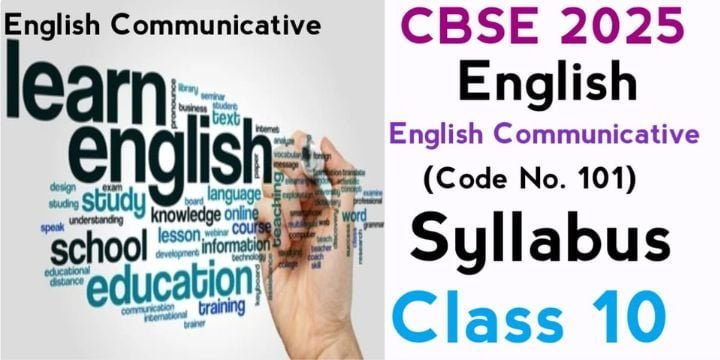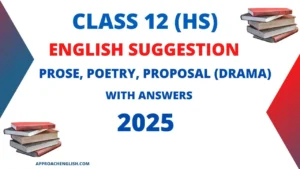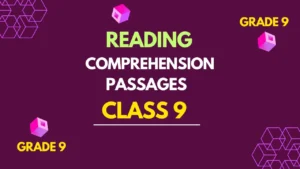The release of the CBSE Communicative English Syllabus for Class 10 for the academic year 2024-2025 on the official website is a significant event in the academic calendar.
The announcement of CBSE Communicative English Syllabus Class 10 2024-2025 typically includes detailed insights into the curriculum, learning objectives, and assessment structure for the academic session 2024-2025.
Class 10 CBSE Communicative English Syllabus 2024-2025
Unveil the blueprint of success as we dissect the CBSE Communicative English Syllabus Class 10 2024-2025. Understand the core components, thematic units, and the overarching structure that shapes students into effective communicators.
Embark on a transformative academic journey as we delve into the CBSE Communicative English Syllabus Class 10 2024-2025. This article serves as your compass, guiding you through the intricacies of the curriculum, and ensuring a holistic understanding.
Download Class 10 CBSE Communicative English Syllabus 2024-2025
Unlock the gateway to academic excellence by downloading the Class 10 CBSE Communicative English Syllabus. This comprehensive guide is your key to mastering language skills, enhancing reading comprehension, refining writing abilities, and exploring rich literature. Download now to embark on a transformative journey of education and linguistic proficiency.
2024-2025 Communicative English(101) Section-wise Syllabus for Class 10 with Marks Distribution
COMMUNICATIVE ENGLISH
(Code NO. 101)
CLASS – X
2024-25
SECTION-WISE WEIGHTAGE
| Section | Title | Total Weightage |
| A | Reading Skills | 20 |
| B | Writing Skills | 24 |
| C | Grammar | 10 |
| D | Literature Textbook | 26 |
| TOTAL | 80 |
People also search
SECTION A: READING SKILLS = (10+10=20 Marks)
Points to note for the Reading Skill Section:
- The section will have two unseen passages with a maximum word limit of 600 words.
- The passages can be of any two types out of the following: literary/factual/discursive.
- For practicing Unseen Passages, students must follow the Main Course Book (MCB)by CBSE 2024-2025
- Objective Type Questions (including Multiple Choice Questions)
- Very Short Answer Type Questions will be asked to test inference, evaluation, analysis, and vocabulary in context.
SECTION B: WRITING SKILLS = 24 Marks
Points to note for the Writing Skill Section:
This section will have a variety of short and long writing tasks.
- Notice Writing for school assembly/ Resident Welfare Association/ School Events/ Classroom information etc. (maximum 50 words) = 4 Marks
- Dialogue Writing, (maximum 100 words) = 5 Marks
- Informal Letter (maximum 120 words) = 7 Marks
- Paragraph on one out of two themes from the Main Course Book (MCB) by CBSE 2024-2025
- Paragraphs will be based on verbal or visual cues (maximum 150 words) = 8 Marks
SECTION C: GRAMMAR (10 Marks)
Points to note for the Grammar Section:
Grammar items will be taught and assessed over a period of time.
- Tenses
- Modals
- Subject-verb concord
- Reported speech
•Commands and requests
•Statements
•Questions - Clauses:
•Noun clauses
•Adverb clauses
•Relative clauses
6. Determiners
The above items may be tested through test types(Integrated Grammar) as given below:
- Gap filling = 3 marks
- Editing or Omission = 4 marks
- Sentences Reordering or Sentence Transformation in Context. = 3 marks
- For Practicing Grammar, Students must follow Work Book by CBSE 2024-2025
SECTION D: LITERATURE TEXTBOOK (26 Marks)
Points to note for the Literature Textbook Section:
- Two out of three extracts from prose/poetry for reference to the context. Very Short Answer Questions will be asked to assess global comprehension, interpretation, inference, and evaluation. = 8 marks (4+4)
- Five Short Answer type Questions out of six from the Literature Reader to test local and global comprehension of theme and ideas, analysis, evaluation, and appreciation (30-40 words each) = 5 x2 = 10 Marks
- One out of two Long Answer type Questions to assess how the values inherent in the text have been brought out. Creativity, evaluation, and extrapolation beyond the text and across the texts will be assessed. This can also be a passage-based question taken from a situation/plot from the texts. (150 words). = 8 marks
Prose:
- Two Gentlemen Of Verona By A.J. Cronin
- Mrs Packletide’s Tiger By Saki
- The Letter By Dhumaketu
- A Shady Plot By Elsie Brown
- Patol Babu, Film Star By Satyajit Ray
- Virtually True By Paul Stewart
Poetry:
- The Frog And The Nightingale by Vikram Seth
- Not Marble, nor the Gilded Monuments (Sonnet 55) by William Shakespeare
- Ozymandias by Percy Bysshe Shelley
- The Rime of the Ancient Mariner by Samuel Taylor Coleridge
- Snake D. H. Lawrence
Drama:
- The Dear Departed by Stanley Houghton
- Julius Caesar by William Shakespeare
Question Paper Design of Class 10 CBSE Communicative English
Communicative English
(CODE NO. 101)
2024-25
CLASS X
| S.No | Competencies | % Weightage |
| 1 | Demonstrative Knowledge + Understanding (Knowledge based simple recall questions, to know specific facts, terms, concepts, principles or theories, identify, define, or recite, information, Comprehension – to be familiar with meaning and to understand conceptually, interpret, compare, contrast, explain, paraphrase information) | Up to 30% |
| 2 | Conceptual Application (Use abstract information in concrete situation, to apply knowledge to new situations; use given content to interpret a situation, provide an example or solve a problem) | Up to 35% |
| 3 | Analysis, Evaluation and Creativity Analysis & Synthesis- classify, compare, contrast, or differentiate between different pieces of information;organize and/or integrate unique pieces of information from a variety of sources. | Up to 35% |
| Total | 100% |
Guidelines for Assessment of Listening and Speaking Skills (ALS)
ALS is a component of the Subject Enrichment Activity under Internal Assessment. ALS must be seen as an integrated component of all four language skills. Suggested activities, therefore, take into consideration an integration of the four language skills but during assessment, emphasiswill be given to speaking and listening, since reading and writing are already being assessed in the written exam.
Assessment of Listening and Speaking Skills: (5 Marks)
i. Activities:
- Subject teachers must refer to books prescribed in the syllabus.
- In addition to the above, teachers may plan their own activities and create their own material forassessing the listening and speaking skills.
ii. Parameters for Assessment: The listening and speaking skills are to be assessed on the following parameters:
a. Interactive competence (Initiation & turn taking, relevance to the topic)
b. Fluency (cohesion, coherence and speed of delivery)
c. Pronunciation d. Language (grammar and vocabulary) A suggestive rubric is given below:
| 1 | 2 | 3 | 4 | 5 | |
| Interaction | Contributions are mainly unrelatedto those of other speakers Shows hardly any initiative in the development of conversation Very limited interaction | Contributions are oftenunrelated to those of theother speaker Generally passive in thedevelopment of conversation | Develops interaction adequately, makes however minimal effortto initiate conversation Needs constant prompting totake turns | Interaction is adequately initiated and developed Takes turnbut needs some prompting | Initiates & logically develops simple conversation on familiar topics Takes turns appropriately |
| Fluency & Coherence | Noticeably/ long pauses; rate of speech is slow Frequent repetition and/or self- correction this is all right in informal conversation Links only basic sentences; breakdown of coherence evident. | Usually fluent; produces simple speech fluently, but loses coherence in complex communication Often hesitates and/or resorts to slow speech Topics partly developed; not always concluded logically | Is willing tospeak at length, however repetition is noticeable Hesitates and/or self corrects; occasionally loses coherence Topics developed, but usually not logically concluded | Speaks without noticeable effort, with a little repetition Demonstrates hesitation to find words or use correct grammatical structures and/or self- correction Topics not fully developed to merit. | Speaks fluently almost with no repetition & minimal hesitation Develops topic fully & coherently |
| Pronunciation | Frequent inaccurate pronunciation Communication is severely | Frequently unintelligible articulation Frequent phonological errors Major communication problems | Largely correct pronunciation & clear articulation except occasional errors | Mostly correct pronunciation& clear articulation Is clearly understood most of the time; very fewphonological errors | Pronounces correctly & articulates clearly Is always comprehensible uses appropriate intonation |
| Vocabulary & Grammar | Demonstrates almost no flexibility, and mostly struggles for appropriate words Many Grammatical errors impacting communicatio n | Is able to communicate on some of the topics, with limited vocabulary. Frequent errors, but self-corrects | Is able to communicate on most of the topics, with limited vocabulary. A few grammatical errors | Is able to communicate on most of the topics with appropriate vocabulary Minor errors that do not hamper communication | Is able to communicate on most of the topics using a wide range of appropriate vocabulary, using new words and expressions No grammatical errors |
iii. Schedule:
The practice of listening and speaking skills should be done throughout the academic year.
The final assessment of the skills is to be done as per the convenience and schedule of the school.
CBSE Prescribed Books Communicative English Class 10
Interact in English Series by CBSE (available on www.cbseacademic.nic.in)
| Main Course Book (2023 Edition)| Official Download |
| Literature Reader (2023 Edition)| Official Download |
| Workbook (2023 Edition)| Official Download |
Related CBSE Class 10 Syllabus
Frequently Asked Questions (FAQs)
What is the significance of the CBSE Communicative English Syllabus Class 10 2024?
Uncover the transformative power of this syllabus, designed to equip students with holistic language skills necessary for real-world communication.
How can students enhance their reading comprehension skills?
Explore effective techniques and resources to elevate your reading comprehension abilities and excel in this crucial section of the syllabus.
What writing styles are covered in the Writing Skills section?
Delve into the diverse writing styles incorporated in the CBSE Communicative English Syllabus Class 10 2024-2025, from creative expression to formal communication.
How does the syllabus contribute to grammar proficiency?
Understand the role of the syllabus in building a strong grammatical foundation, ensuring precision and clarity in language usage.
Why is literature exploration essential in the curriculum?
Discover the broader educational benefits of exploring literature, fostering empathy, cultural understanding, and critical thinking.
What makes the CBSE Communicative English Syllabus Class 10 2024 student-centric?
Explore the features and approaches that prioritize students’ needs, making the learning experience engaging, relevant, and impactful.







